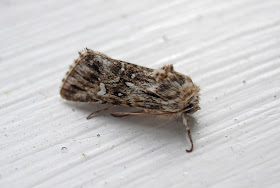Here's the latest in the unfolding global apocalypse. As limits to economic growth are reached fundamental capitalist corporations are escalating the advance into the nature protected network in order to process additional natural capital into economic capital. In a European context it doesn't get much bigger than this (see message below from Spain's main birder Dani Lopez) in terms of the length these corporations will go to feed their addiction to growth at the expense of nature. These corporations are literally giant malignant organisms, like cancers spreading across the globe. On a local scale to me Viridor are the manifestation of that global disease- a disease that if not eradicated will consume everything. All an individual like myself can do is to try and fight back the disease that is trying to consume me, my family and my local area.
Of course not all corporations are diseases but many are and it is these ones that need to be stopped. A corporation working closely within environmental and social value systems is the greatest force for positive progress on the planet. A primitive, rogue cancerous corporation, like Viridor, is the greatest threat to progress on the planet.
Hundreds of working class people being burnt in their beds, many burnt to death a couple of weeks ago by the Capitalists (see more
HERE from the Grenfell Action Group) and now other Capitalists burning one of Europe's great national parks- things are stepping up.
The Apocalypse is escalating and everyone and everything is in mortal danger. The fundamental Capitalists are the threat to humanity and the planet of our times- the modern equivalent of the imperialists, the catholics, the pillaging nomads and other manifestations of distilled evil which pop up from time to time in history- and each time are successfully sent back to hell from where they have come.
The Donana burns today.
PLEASE, READ. Just in case you haven´t heard about it yet... The incomparable Doñana National Park is IN FLAMES. As you all know, Doñana has a biodiversity that is not only unique in Europe, but in the World, with sheer numbers of breeding and wintering birds, mammals, reptiles, fish, insects and plants. It`s home to critically endangered Iberian Lynx and Spanish Imperial Eagles, amongst many, many other things. The fire -which seems to have been INTENTIONAL!!-, has nearly reached the lynx breeding centre, and apparently only about 10 of the 30 lynx there have been captured by the staff. The rest, which accounts for a good percentage of the entire world population, might have run away, hopefully, but some might now be dead, burnt alive. Fucking disgraceful people who did this, you only deserve death. But wait, theres more. One of the major gas companies in Spain -Gas Natural- wanted to build gas tanks exactly at the place where the fire is. In 2015 they presented their project. The year before, the government approved a law which stated that land which had been burnt could be re-zoned as long as the project was of "public utilty". Guess what? Last year, our government declared the oil company project of "public utility". They only needed the land to be burnt in order to go ahead....In tears now.


















































